Build Details

View the '29 Roadster technical specifications
Chassis
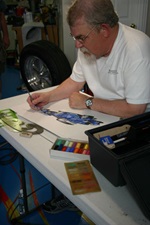
Our dream started as an idea in the mind of Wayne Reece, Miller District Manager and long-time car enthusiast. The design was to feature a few unique aspects for a 1929 roadster such as power windows, a removable hardtop, and a trailer that tows an engine-driven welder. Frank Banta helped turn our dreams into reality, as he drew the concept onto paper. The picture inspired those involved on the build from fabrication to the first turn of the key.
The power behind the '29 Roadster is something that can't be kept quiet for long. From the ground up, the roadster is nothing short of a finely tuned piece of art on wheels.
A perfectly reproduced '29 Ford Model A frame was assembled in roughly 8 hours by skilled mechanics with Total Cost Involved (TCI), out of Ontario, Calif. TCI has been reproducing classic frames for years and had the frame's exact schematics. The only thing left to do was weld.
The Dynasty 300 DX was used to TIG weld the frame to Wayne Reece's design specifications to accommodate the engine and transmission. The internal firewall of the Roadster was recessed by 5 inches, making the engine compartment slightly smaller but increasing the much-needed legroom in the cab. Hand removing any millscale is important to get a solid weld, which only adds to the clean appearance of the weld achieved with the control of the Dynasty 300.
An independent front suspension gives the Roadster the ability to glide over the pavement. Common in modern hot rods, it gives passengers a smoother ride and more control from side to side than a dropped front axle usually found in hot rods looking for a nostalgic feel.
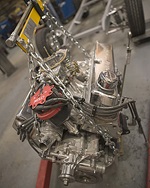
The Roadster gets its captivating rumble from a Roush 302, 453 horse power stroker engine with aluminum heads and a special Edlebrock aluminum intake, which gives the already impressive engine slightly more horsepower. This is a unique upgrade to the roadster considering that in 1929, the original vehicle only had a 40 horsepower engine.
Mostly aluminum, the engine is lighter than a standard engine; only the block itself is cast from steel. Very few street rods have a Roush engine in them. Miller has worked closely with Roush Performance, supporting their record-breaking efforts in NASCAR while developing a tight relationship. Roush Performance liked the concept of keeping a Ford engine in a Ford vehicle, which is also not so common in today's hot rod industry.
Built by Phoenix Transmissions out of Texas, the Roadster has a Ford C-6 transmission with a 2,200 RPM stall converter, offering all the gear ratios necessary while protecting the engine. The C-6, is a heavier transmission with heavier shift and gear kits to handle the power of the 302 over a standard, yet smaller C-4. A Lokar floor-mounted shifter was easy to install and provides smooth functionality, and feedback.
Body
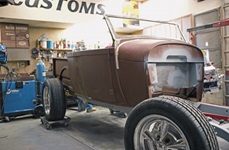
Brookville Roadster of Brookville, Ohio, built the cab with an extended six inches, increasing legroom. The extension was MIG welded using a Millermatic 251 and any seams were filled, giving the cab a unified look.
An angle was then cut into the doorposts of the car to flush-fit the doors that would be later added to the cab. The windshield posts on the cab were laid back 25 degrees and welded, allowing for glass to be placed in the doors. Amazingly enough, the Roadster was designed with windows in mind, a very unique, very rare feature.
The bed of the car features stained oak liners, complementing the original design of the car. The bed itself had to be shortened six inches for everything to fit on the frame, allowing the roadster to keep the same wheel base and body length that was intended.
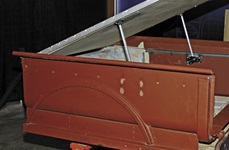
The bed features a hardtop cover that is motorized to raise and lower, displaying a state-of-the-art stereo and DVD system from Metra Electronics that runs off the car's battery. The bed cover, designed by Wayne Reece and built out of aluminum, is covered in Mercedes cloth. On the interior, a painted resin shell holds all the stereo components and weighs approximately 200 pounds fully assembled. Reece used a Dynasty 200 DX to TIG weld the 1-inch box tubing and 1/2-inch solid aluminum bar to house the stereo electronics.
The '29 Roadster features a removable hardtop designed by Reece and Pat Keating and built with the help of Ron Covell. Unique to a street rod, the hardtop was built exclusively out of aluminum box tubing with an aluminum skin. Upholstered by Billy Scott Jr. of Scotts Jr. Interiors, Louisville Ky., the exterior is covered in Mercedes cloth right down to the hand-stitched seams, popular in modern street rods. The interior features a light-gray suede velour headliner with inserts of gray ostrich hide from South Africa. The leather and matching headliner wonderfully complement each other and offer a slightly different look than alligator hide, which is more commonly used.
The hardtop is astonishingly light, weighing in at 10 pounds, and was designed with unique window tracks, keeping water out and driving enjoyment in. Top on or top off, the Roadster is stylish from cab to bed and ready for the road in any weather.
Door
Several surprises make Miller's '29 Roadster unique, from functionality to design. Wayne Reece and Pat Keating designed the Roadster with flush-fitted doors. This reduces paint scuffing and wind noise associated with the original doors, which overlapped along the outside edge of the quarter panel or splash apron.
"They said it couldn't be done," explains Miller's Wayne Reece because windows — much less power windows — are not commonly found in a classic roadster. At best, some roadsters had a plastic snap-in curtain that offered meager protection against rain. "Blending modern convenience with classic style is one of the unique aspects this design," says Reece. "We even designed the roadster to have heat and air conditioning."
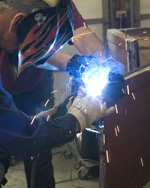
To form a close seam, Pat Keating used a Spectrum 625 to cut angles into the windshield posts of the car and added metal to the door. He laid the posts back 25 degrees to create an angle for the glass windows in the door. The inside skin of the door was cut and removed to expose the inner frame, which was also removed, then resized and welded back in with a Millermatic 251 to accommodate the internal window components.
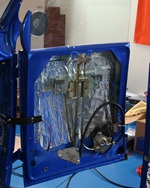
An aftermarket power window kit was selected for its flexible motor shaft, which would ensure functionality in the door's narrow interior. As a finishing touch, a customized door panel on the inside of the car hides the window's motor and corresponding gear cables.
Windows were designed from cardboard patterns, cut out, fitted to the door and transferred to a final plywood pattern. Brill Glass of Louisville cut the glass to fit using the wooden templates. A final check on the working door ensured correct operation before Brill tempered the glass prior to the final installation.
Using a Millermatic 251, Pat Keating fabricated an ornate fixture to hold the Roadster's original '29 mirror. This enhances the original single rod design by filling in the space between the mirror and the windshield post.
Inside, sleek bezels surround the instrument cluster and flow over the top edge of the dash. Bruce Carnahan of MotorHead Jewelry in Louisville handcrafted the bezels out of aluminum and chrome plated them for the custom hot rod appeal.
Interior
Nothing beats slipping into the comfortable form-fitted seats of a street rod. Upholstery should feel as good as it looks and Billy Scott Jr. of Scotts Jr. Interiors, Louisville, Ky., masterfully handcrafted the interior and exterior upholstery for the '29 Roadster in 2 weeks.
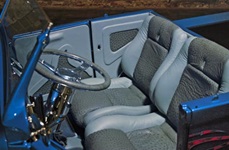
Imported Australian leather and South African Ostrich hide were skillfully stitched using patterns from Feiro bucket seats that were lowered 5-inches to account for the removable hardtop. The exterior of the hardtop is padded, then covered in black Mercedes cloth and stitched to fit, popular with modern street rods. Inside, a light-gray, super-suede headliner with a gray ostrich hide insert add a detailed touch to the top of the cab.
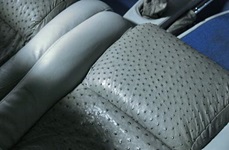
Working his way from the top down, Scott crafted door panels out of gray leather and ostrich hide stretched over a cloth and resin shell sized to the measurements of the door. The panels are connected to the door using internal clips instead of screws, concealing any hardware and offering a cleaner look.
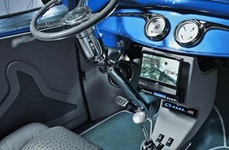
Driver and passenger side kick panels were created out of the matching leather to hold speakers that will fill the cab with music through a custom stereo and DVD system outfitted by Florida based Metra Electronics.
The carpet and floor mats are a Daytona weave refurbished from a popular '50s design.
A high performance engine isn't the only thing making noise on the roadster. Installed by Metra Electronics, a 600 Watt amplifier powers a JBL stereo system with two midrange speakers and tweeters embedded in driver and passenger side kick panels with a flip-out 7-inch T.V. screen centered below the dash'and that is — just in the cab.
The bed cover holds the rest of the audio and video goodies. When raised for display, the Roadster has two more speakers and tweeters on the back wall of the bed, a compositor bank flanked by two 7-inch T.V. monitors and one 10-inch monitor front and center under the bed cover.
Drawing onlookers to the back of the bed is an oval backlight display with the words Dream It. Weld It.® plasma cut out of steel. Embedded into a resin that is backlit with a purple and blue light, the phrase captures all eyes that are not watching one of the three T.V. monitors and celebrates the attitude of the do-it-yourselfer, much like the team that assembled the roadster. From conception on paper to the sound of the engine as it was first brought into a rumbling existence, Miller built the Roadster to empower others to do the same, with the tools to make their dreams a reality.
Exterior
With wheels designed by auto enthusiast Chip Foose the Miller '29 Roadster rolls down the street in style.
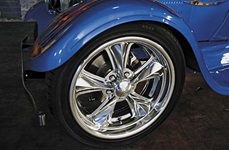
Nostalgia is what paved the way in the quest for finding the right wheels for the Roadster. Popular in the 60's and 70's, the wheels are a reintroduced classic 5-spoke spindle design produced by Foose. Wheel hubs were drafted in a computer assisted design program and then cast out of Aluminum.
Two 17-inch BF Goodrich tires were selected for the front of the Roadster due to their sleek, low-profile look and good tread pattern for all weather driving. Power anchors the back of the Roadster to the pavement, with two larger 35-inch tires giving the appearance that the vehicle is in constant motion even when sitting still.
According to Wayne Reece, "When towing the trailer, the driver doesn't even notice that anything is back there. It's such a smooth ride."
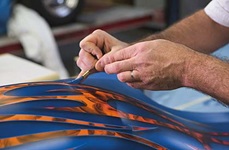
Looking sharp from the ground up leads to the next mandatory ingredient in hot rod customization: the paint job. Reece came up with general ideas about how the roadster should look and Dan Taylor of Taylor's House of Color, Louisville, Ky., painted free flowing flames that give the roadster its exterior personality.
The base coat is a Dupont paint color called Blue Mood, and the paint job is one-of-a-kind. Reece explains 'It's a combination of several different styles, and I wanted to have the design come out the louvers in the engine cowling and flow through the 1929 Miller logo, making it look three dimensional and pop right off the car.'
The 1929 Miller logo was chosen to be period appropriate with the year of the car being the same year Miller was founded. In fact, it's the same logo that appeared on the first service vehicles.
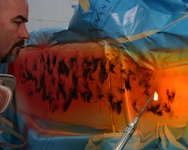
After the base coat is applied, the car is completely masked off except for the shapes of the flames that are exposed to three degrees of yellow, orange and red airbrushed paint. Using a Smith torch, smoke clings to the paint, creating a unique flame effect. The finishing touches are added with a shadow, pin-striping and clear coat, sealing the design. With the masking removed, realistic flames appear flowing from the engine cowling, over the fenders, and trail down the sides and off the back of the cab, making for one hot ride.
Trailer
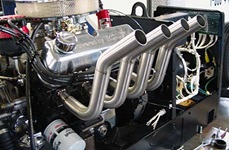
The Roadster's paint job isn't the only thing that demands attention while driving down the road. Totally unique to this vehicle, the roadster tows a matching trailer with a ready to weld Miller Trailblazer 302 engine-driven welder.
The Trailblazer 302 originally had a 20 horse-powered Kohler engine that was upgraded to a 302 Roush that puts out 320 horsepower. The engine, hooked to the alternator, generates auxiliary power and works great for welding. A '29 Ford radiator was used with matching shell and paint job, tying the design of the Trailblazer together with the Roadster.
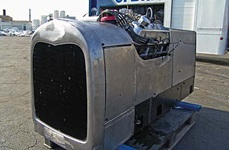
The trailer itself features a Super Bell dropped axel with an air ride system designed to raise and lower the welder. The welder and the trailer were extended about 12 inches to accommodate the added radiator grill. From start to finish, the welder and trailer took approximately a week to complete.
"The guys in the metal shop and the Miller Electric Mfg. Co.'s factory in Appleton, Wis., really helped to pull this together," said Reece. "They did a great job mounting the upgraded engine to the adapter plates, linking the alternator and spinning the wiring."
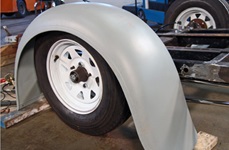
The Roadster features reproduced '29 Ford fenders and matching taillights furnished by Brookville Roadster, Brookville, Ohio. After the rear fender is installed on the cab, running boards are attached to stabilize the fenders from rattling and twisting in the wind as the roadster cruises down the road.